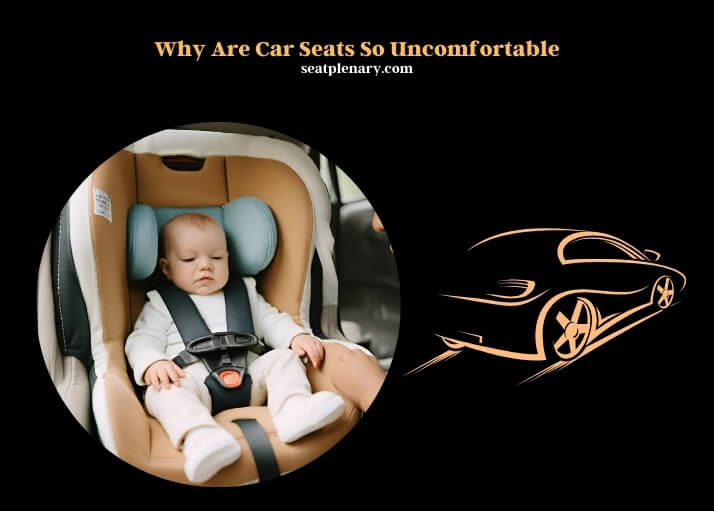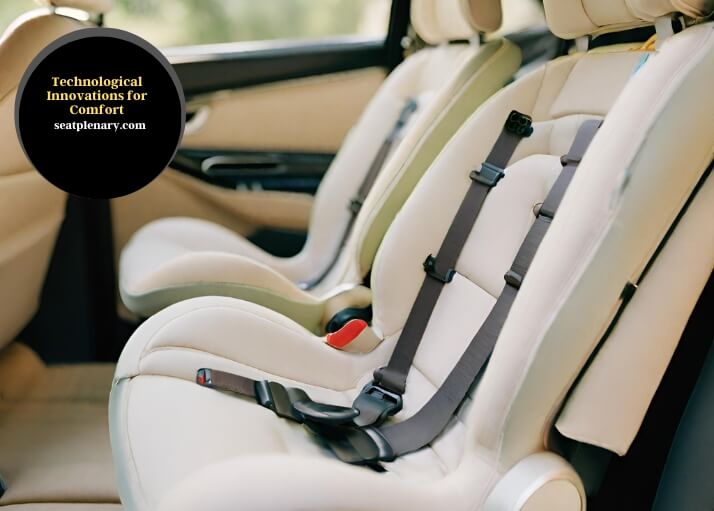Car seats are often uncomfortable due to limited adjustability and poor ergonomic design. These factors can lead to discomfort, especially on long drives.
The discomfort experienced in car seats stems from a variety of design and functionality issues that fail to accommodate the diverse needs of drivers and passengers. Limited adjustability means that individuals cannot tailor the seat position to their specific body dimensions, leading to poor posture and discomfort over time.
Furthermore, the materials used in car seats, such as hard foams or non-breathable fabrics, can exacerbate discomfort by not providing adequate support or ventilation. The ergonomic design of car seats frequently overlooks the importance of leg and thigh support, seat width, and the correct angle to promote a natural sitting posture. This oversight can result in increased pressure on the lower back and legs, restricted blood flow, and heightened fatigue during and after driving.
Temperature regulation within the seat itself is often neglected, making seats too hot in summer and too cold in winter, further detracting from the overall comfort. Addressing these issues requires a holistic approach to car seat design, focusing on adjustable features, supportive materials, and ergonomic principles to ensure comfort for all occupants, regardless of their size, shape, or driving duration.

Seat Design and Material Impact
The comfort of car seats is significantly influenced by their design and the materials used. The primary goal of seat design is to support the driver and passengers’ posture, reduce fatigue, and enhance the driving experience.
Many car seats fall short due to the use of hard, non-breathable materials and a one-size-fits-all approach to design. Seats often lack the necessary contouring and support, leading to discomfort during short drives and pain over longer distances.
Materials such as leather and synthetic fabrics, while aesthetically pleasing, can cause discomfort due to poor breathability and flexibility.
The density and resilience of the foam used in car seats can greatly affect comfort levels. Seats with too soft or too firm foam can lead to poor posture and discomfort.
Ergonomic design principles suggest that car seats should provide adjustable lumbar support, have breathable fabric covers, and include foam that molds to the body’s shape while offering firm support. Unfortunately, many vehicles do not meet these criteria, leading to a mismatch between the seat design and the occupants’ needs for comfort and support.
Common Materials Used in Car Seats and Their Comfort Ratings
| Material | Comfort Rating | Breathability | Durability |
| Leather | Medium | Low | High |
| Fabric | High | High | Medium |
| Synthetic Leather | Low | Medium | High |
| Mesh | High | Very High | Medium |
Health and Body Type Considerations
Individual health issues and body types play a crucial role in the perception of car seat comfort. People with back problems or other health conditions may find standard car seats particularly uncomfortable due to insufficient support.
The wide variance in body shapes and sizes means that a seat design that is comfortable for one person may be unsuitable for another.
The lack of adjustability in many car seats exacerbates these issues. Seats that do not offer adjustable lumbar support, seat height, and tilt can force the occupant into an unnatural and uncomfortable position. This one-size-fits-all approach neglects the diverse needs of drivers and passengers, leading to widespread discomfort.
To address these challenges, car manufacturers need to focus on creating seats with a higher degree of adjustability and support. Features such as adjustable lumbar support, seat depth adjustment, and even adjustable firmness can make a significant difference in accommodating individual needs for comfort and support.
Long Drive Discomfort
Extended driving periods can magnify the discomfort experienced in poorly designed car seats. The lack of proper support and adjustability means that drivers and passengers are more likely to experience fatigue, stiffness, and pain. This discomfort is not only a matter of physical pain but can also distract the driver and reduce concentration, potentially leading to safety issues.
Supportive features such as adjustable lumbar support and seats that can be tilted and shifted are essential for maintaining comfort on long drives.
Incorporating elements that promote good posture and reduce the risk of muscle strain can significantly improve the driving experience.
Psychological factors also play a role in long-duration driving discomfort. The anticipation of discomfort can increase tension and reduce the overall enjoyment of driving. Addressing the physical aspects of seat design can help mitigate these psychological effects, making long drives more pleasant and less taxing.
Technological Innovations for Comfort
Recent technological advancements have introduced a range of features aimed at enhancing car seat comfort. Adjustable lumbar supports that can be customized to the driver’s preference, heating and cooling options for temperature control, and memory foam that conforms to the occupant’s body shape are just a few examples of these innovations.
Smart seats represent the future of car seat comfort, with sensors that adjust the seat automatically to the driver’s body shape and preferred positions. These technologies promise to make car seats more comfortable and personalized, addressing many of the issues with current seat designs.

The adoption of these technologies varies widely among manufacturers and models, often making them accessible only in higher-end vehicles. As these features become more common, they have the potential to significantly improve comfort for all drivers and passengers.
Expectations vs. Reality in Seat Design
The gap between consumer expectations and the reality of car seat comfort is a significant issue. Marketing materials often highlight the luxuriousness and comfort of car seats, but the reality can fall short, especially in lower-priced vehicles. This discrepancy can lead to dissatisfaction and the perception that comfort is only available in premium models.
The challenge for manufacturers is to balance cost, design, and comfort, making ergonomic and adjustable seats accessible across all vehicle segments. Customizable seats, where drivers can select from a range of options to suit their preferences and needs, could represent a solution to this challenge.
FAQs
Limited Seat Adjustment Options
Many car seats offer limited adjustment options, making it challenging for drivers and passengers to find a comfortable seating position. This lack of customization can lead to discomfort, especially on longer journeys.
Seats often allow for basic adjustments like forward and backward movement or recline angle, but they may not provide enough range to accommodate all body types and preferences. For instance, taller individuals might find legroom inadequate, while shorter drivers may struggle to achieve optimal visibility and control access.
Enhancing seat adjustability, including height, lumbar support, and tilt options, could significantly improve comfort for all occupants.
Insufficient Leg and Thigh Support
A common complaint is the lack of adequate leg and thigh support, which can lead to discomfort and fatigue during long drives. Many car seats are designed with a one-size-fits-all approach, failing to offer the necessary support for different leg lengths and body types.
This can result in poor circulation and increased pressure on the thighs and lower back. Providing adjustable seat cushions that extend or retract to match the occupant’s leg length could alleviate this issue, ensuring better support and reducing the risk of discomfort on long journeys.
Is the discomfort in car seats similar to the issues with Bumbo seats?
The potential risks of bumbo seats, like discomfort in car seats, can impact a child’s comfort and safety. Both can contribute to issues like poor posture or restricted movement. It’s important to consider these factors and make informed decisions when choosing seating options for young children’s well-being.
Seat Width and Space Constraints
The width of car seats and the space available can significantly impact comfort, especially for larger individuals or those with wider body frames. Seats that are too narrow can cause pressure points, restricting movement and leading to discomfort over time.
The space between the seat and the vehicle’s center console or door may be insufficient, further limiting room for adjustment and comfort. Expanding seat width options and considering more generous spacing in vehicle interior design could help accommodate a broader range of body types, enhancing comfort for all passengers.
Impact of Seat Angle on Posture
The angle of the car seat plays a crucial role in maintaining a comfortable and ergonomically correct posture. Seats that are too flat can cause the pelvis to tilt backward, leading to slouching and lower back pain. Conversely, seats angled too steeply can put unnecessary pressure on the thighs and lower back.
An ideal seat design would offer adjustable angles, allowing occupants to find a position that supports natural spinal alignment and reduces strain on the back and legs. Incorporating features that enable fine-tuning of the seat angle could greatly improve overall comfort and posture during driving.
The Role of Seat Stiffness in Discomfort
Seat stiffness is another factor that contributes to discomfort in car seats. Seats that are too hard can create pressure points, while those that are too soft may not provide adequate support, leading to poor posture and discomfort. Finding the right balance of firmness is key to ensuring comfort, especially during longer drives.
Materials that offer a combination of support and cushioning, such as high-resilience foam or gel inserts, could improve seat comfort by distributing weight evenly and reducing pressure points.
Temperature Regulation in Car Seats
Temperature regulation within car seats can greatly affect comfort levels, with seats becoming too hot in summer or too cold in winter. Traditional materials like leather and vinyl can exacerbate these temperature extremes, making the seat surface uncomfortable.
Incorporating breathable fabrics, ventilation systems, and temperature control features such as heating and cooling options can significantly enhance comfort. Advanced materials that regulate temperature and wick away moisture could also improve the overall driving experience by maintaining a more consistent and comfortable seat temperature throughout the year.
In conclusion, the discomfort experienced in car seats is a multifaceted issue, influenced by design, materials, personal health, and technological advancements. These factors requires a holistic approach to seat design, focusing on ergonomics, adjustability, and the incorporation of new technologies. As manufacturers respond to consumer demands for greater comfort, the future of car seating looks promising, with innovations that offer personalized comfort solutions for all drivers and passengers.
